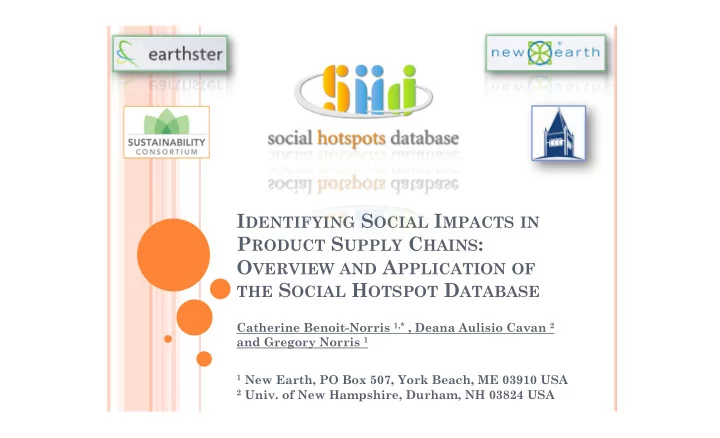

I DENTIFYING S OCIAL I MPACTS IN P RODUCT S UPPLY C HAINS : O VERVIEW AND A PPLICATION OF THE S OCIAL H OTSPOT D ATABASE Catherine Benoit-Norris 1,* , Deana Aulisio Cavan 2 and Gregory Norris 1 1 New Earth, PO Box 507, York Beach, ME 03910 USA 2 Univ. of New Hampshire, Durham, NH 03824 USA
E MERGENCE OF S OCIAL LCA Derived from well-established fields of environmental LCA and Corporate Social Responsibility Considers social and socio-economic impacts thoughout the life cycle of products, including raw material extraction, manufacture, distribution, use, and disposal Guidelines developed by UNEP-SETAC Task Force in 2009 More research is needed on methods
S ITE S PECIFIC VS . G ENERIC D ATA Site-specific data is preferred, however, it is timely and cost-prohibitive due to complexity of supply chains Generic data can be used to identify “hotspots” or places in the supply chain that may be of great risk for social issues These hotspots should be specific to a unit process in the supply chain which takes place in country-specific sector (CSS)
S OCIAL H OTSPOT D ATABASE (SHDB) Eases inventory data collection effort – time & cost Consists of Social Theme Tables by country and sector and points to CSS that are at risk or offer opportunity for improvement References publicly available, international, secondary sources on human and worker rights, investment in people & community, and positive business practices. Data indicators are characterized for level or risk or opportunity (eg., low, medium, high, very high) Uses a Worker Hours Model to determine the CSS with the greatest share of labor in the supply chain
S OCIAL T HEME T ABLES Currently in Database NEW as of Sept 30!! Labor Laws/Conventions Unemployment Wage Assessment Health Issues Population living in Poverty Smallholder vs. Commercial Farms Child Labor Injuries and Deaths in the Workplace Forced Labor Migrant Workers Excessive Working Time Freedom of Association, Collective Bargaining, Right to Strike Upcoming Upcoming Legal System Indigenous Rights Toxics in the Workplace Gender Equity Corruption High Conflict Zones Intellectual Property Rights / Traditional Knowledge Children Out of School Access to Improved Drinking water Access to Improved Sanitation Access to Hospital Beds
W ORKER H OURS M ODEL Economic Input/Output model by Global Trade Analysis Project (GTAP) used to determine wage payments by country and sector Wage rates by country and sector available from International Labor Org (ILO) and other sources Divided Wage Payment/$ output in a CSS by the wage rate ($/hr) in that CSS to obtain data on Hours per $ output for Worker Hours Model
S OCIAL S COPING A SSESSMENTS (SSA) The SHDB was tested on 7 pilot studies for different product categories Supply chain of product was evaluated using Worker Hours Model and literature review of the necessary materials and processes Resulted in 2 CSS lists modeled with SHDB A Hotspot Index was calculated for each CSS that incorporated number of social issues weighted by risk level and share of worker hours CSS with highest Hotspot Index are recommended as “hotspots” that should be investigated further for full S-LCA
S TRAWBERRY Y OGURT SSA The two primary CSS of interest, the dairy products and fruit and vegetables sectors in the U.S. were assessed with Worker Hours Model Other CSS were determined through literature review The following CSS were found to be hotspots: Sectors ¡to ¡be ¡aware ¡of: Countries ¡to ¡be ¡aware ¡of ¡within ¡sector: Vegetables ¡and ¡Fruits ¡-‑ ¡strawberries USA, ¡Mexico, ¡China Corn ¡and ¡other ¡cereal ¡grains USA Animal ¡products ¡-‑ ¡gela>n India, ¡China Other ¡foods ¡-‑ ¡starches China Sugarcane, ¡beet ¡sugar, ¡oil ¡seeds India Chemical ¡products ¡– ¡containers China, ¡Venezuela, ¡Indonesia Petroleum ¡products ¡-‑ ¡fer>lizers China
S OCIAL I SSUES FOR H OTSPOTS IN S TRAWBERRY Y OGURT S UPPLY C HAIN
C ONCLUSIONS SHDB is a good resource for determining social hotspots in supply chains Results were confirmed by a literature review of the prominent social issues that exist in the strawberry and dairy industries, including media campaigns Strawberry yogurt made in the U.S. has issues within its supply chain both in the U.S. and in other countries like Mexico, China, Venezuela and India Companies should use this data to investigate hotspots deeper with site-specific audits of their suppliers
Recommend
More recommend